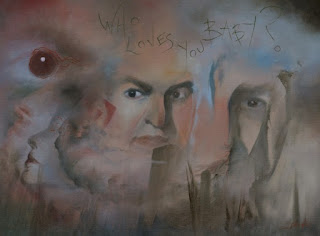More scanning of older paintings today. Here are a couple of studies or first versions. I'll Be Here For You and Except For The Hatred:
Both of these ideas, coincidentally, came directly from dreams. For I'll Be Here For You, I saw a figure writhing in a sandstorm behind glass, in a sort of zoo enclosure. For Except For The Hatred I saw a ballerina on my parents' bed. I was painting her and wrote "Except For The Hatred" in red paint on the canvas, just as in the final versions.
I've been thinking about scenic integration recently, and can see how my art has moved between a few philosophies regarding the 'realism', actualisation of a scene. Sometimes I've painted a room or outdoor scene with objects of symbolism or ideas, and I gradually converted my initial ideas into more realistic looking scenes or locations by creating models and lighting these. This is one philosophy.
But I've also had a second thread of painting things, symbols, ideas that are not spatially consistent, more abstract or 'cubist' looking. Cubism is/was a visual rather than mental concept, showing an object from several sides at once to get its whole at a glance. My art philosophy has always been more like this, like Picassos idea of surrealism; he, remember, coined the very word to mean a hyper-reality, a totality.
I develop ideas in different ways, all intended of course to capture an emotion and intellectual idea, as art does. I occasionally experimented, not so much planned beforehand but improvised. The Toad painting was one example of freely painting without a previous plan or outline guide, a sort of improvisation to capture a mood in the same way as I play music.
Recently, I've started to add echoes and repetitions of shapes, perhaps also in a similar way to music, perhaps the result of these years of my concept of 'symphonic painting' which began back with the Migraine Tree those years ago. The ekphrastic paintings, and the paintings like Who Loves You Baby? extoll this:
These ideas are in a contrast to the 'spatial realism' of a scene, there is little sense of place or room or location, but they are not abstracted or artificial. The worst crime of abstract art is making itself pretty to be decorative. Adding every colour just because it balances! Kandinsky almost became a decorative painter.
No, not abstraction, but realisation, a cubist/hyperreal, genuinely surreal representation.





